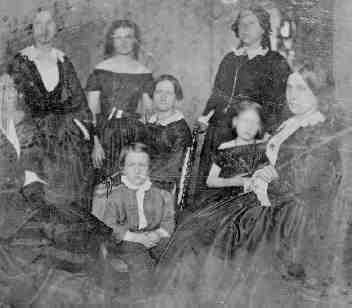
Figure 1.--This American boy wearing long pants is pictured here with his family in the 1850s. He has a modest ruffled collar with a rather plain, boyish looking suit. |

|
We see boys and men wearing ruffled collars in the early 19th century. Open ruffled collars generally became less common after the 1830s. Instead boys wore plainer collars. Some were wide collars, others were qite small. We are able to fillow this in some detaiol because of the appearance of photography which provide us for the first time large numbers of images. The boys still dressed in ruffled collars by mid-century tended to have much smaller ones than in earlier decades. They were no longer worn open, but rather always closedby mid-century. In addition, it became increasingly common to wear bows with the closed collars. Ruffled collars declined in the 1870s.
Boys at mid-century were wearing small plain collars. We are not entirely sure about the 1840s, but this was certainly the case in the 50s and 60s. Many boys had a best shirtwaist or blouse with modest-sized collars. The collars were done in different styles, uut euffled collars were certainly one of the popular styles. We assume the ruffles were a style for best wear. The rulled collars were small, sometimes so small that they could rarely be seen. We have considerable chronological information because of the popularity of dags and ambros in the 1840s and 50s, although it is difficult to differentusate the 1840s and 50s dags. We have very few 40s and 50s images from Europe because dags and ambros were much less common.
A good example of a small ruffled collar is an unidentified Americam boy, we think in the 1840s. We see another unidentified American boys, we believe in the early 1850s. This new small collar size continued to be fashionable during the 1850s and 60s. We note a German boy about 1862. Collars began to grow in size durbg the 1870s, but it was not until the 1880s that really large collars became fashionable.
We note a range of ruffled collar styles in the mid-19th century. Some were very small, so small that they barely can be seem. Others were prominant, but none were really large like the ones seen in the late 19th century. The largeset collars look to be about 1 inch wide or no larger than 1.5 incches, estimating the sizes from the photographs. .
Younger boys commonly wore small ruffled collars in the mid-19th century. There seem to be some difference from country to country as to the appropriate sizes for these collars. We see many American boys with these collars, although they are sometimes so small so to be virtually indiscernable. The popularity of dags and ambros provide us a substantial numbers of images. The rarilty of these early photograph types in Euroipe complicates our country assessment, but we do see small ruffeled collars in Europe. They were also worn in Germany. A good example is a Poznan boy in the 1860s. We also notice two German brothers in 1864. Their ruffeled collars were larger than those we see American boys wearing at the time.
Boys in the early 19th century wore comfortable looking open collars. Some had fancy ruffled, but the open collars still looked rather comfortable. This gradually changed and by mid-century, boys like their father were wearing closed collars. It would not have been thought prope to appear in public with an open collar.
Collars on boys' shirts and blouses in the 1840s became increasingly small. The collars actually looked distinctly modern, although they did not have the pointed lapels of moden collars. Many of the collars were quite plain, especially those for every day wear. Boys might wear fancier ruffled collars for special events. This was a detinctly juvenile style. While men might have worn ruffled collars in the early 19th cerntury, this was no longer the cade by the mid-19th century. While boys were wearing ruffled collars for dress wear by mid-century, they were usually very small modest collars with only a hint of lace.
Some of the jackets during the mod-19th century were done with half sleeves and worn with blouses that had baloon sleeves. A good example is the German boy in 1862.
Wrist ruffles to match the ruffled collars were no common for boys at mid-century. Some boys did begin to wear matching wrist ruffles in the 1860s. Like the collar ruffles they were modest in size and often difficult to make out in the early photographs.
Now that boys were wearing closed collars, they often wore bows or other types of neckwear. Neckwear was not required. Many boys just wore a closed collar. As time progressed, however, some type of neckwear became increasingly common. The neckwear included small bows, bowties, stocks, or sting tie. Like the collars, the neckwear was inveribly small to match the small size of the collar.
Navigate the Boys' Historical Clothing Web Site:
[Return to the Main ruffled collar chronology page]
[Return to the Main collar page]
[Introduction]
[Activities]
[Biographies]
[Chronology]
[Cloth and textiles]
[Clothing styles]
[Countries]
[Topics]
[Bibliographies]
[Contributions]
[FAQs]
[Glossaries]
[Images]
[Links]
[Registration]
[Tools]
[Boys' Clothing Home]
